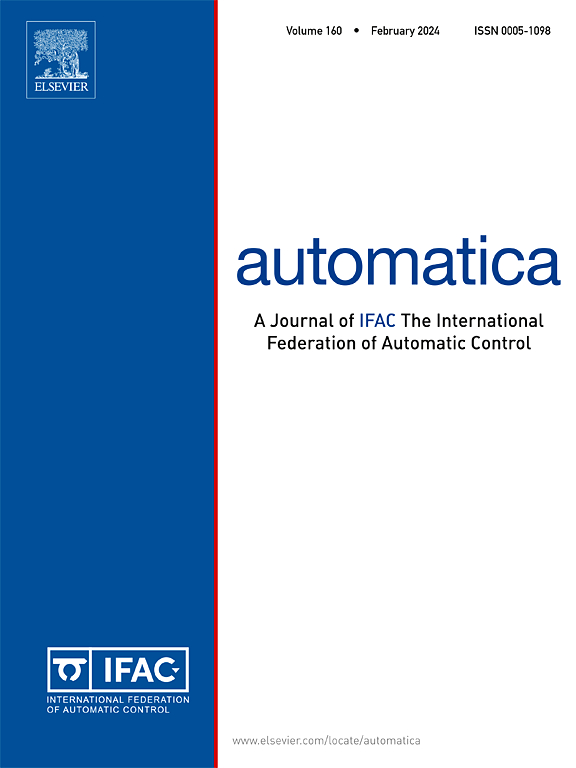Output feedback periodic event-triggered and self-triggered boundary control of coupled 2 × 2 linear hyperbolic PDEs
IF 5.9
2区 计算机科学
Q1 AUTOMATION & CONTROL SYSTEMS
引用次数: 0
Abstract
In this paper, we expand recently introduced observer-based periodic event-triggered control (PETC) and self-triggered control (STC) schemes for reaction–diffusion PDEs to boundary control of 2 × 2 coupled hyperbolic PDEs in canonical form and with anti-collocated measurement and actuation processes. The class of problem under study governs transport phenomena arising in water management systems, oil drilling, and traffic flow, to name a few. Relative to the state of the art of observer-based event-triggered control of hyperbolic PDEs, our contribution goes two steps further by proposing observer-based PETC and STC for the considered class of systems. These designs arise from a non-trivial redesign of an existing continuous-time event-triggered control (CETC) scheme. PETC and STC eliminate the need for constant monitoring of an event-triggering function as in CETC; PETC requires only periodic evaluations of the triggering function for event detection, whereas STC is a “predictor-feedback” that anticipates the next event time at the current event exploiting continuously accessible output measurements. The introduced resource-aware designs act as input holding mechanisms allowing for the update of the input signal only at events. Subject to the designed boundary output feedback PETC and STC control laws characterized by a set of event-trigger design parameters, the resulting closed-loop systems, which are inherently Zeno-free by design, achieve exponential convergence to zero in the spatial norm. We illustrate the feasibility of the approach by applying the control laws to the linearized Saint-Venant model, which describes the dynamics of shallow water waves in a canal and is used to design flow stabilizers via gate actuation. The provided simulation results illustrate the proposed theory.
耦合2 × 2线性双曲偏微分方程的输出反馈周期事件触发和自触发边界控制
本文将最近提出的基于观测器的周期事件触发控制(PETC)和自触发控制(STC)方法推广到典型形式的具有反配位测量和驱动过程的2 × 2耦合双曲PDEs的边界控制。所研究的这类问题控制着水管理系统、石油钻探和交通流量中出现的运输现象。相对于基于观测器的双曲偏微分方程事件触发控制技术的现状,我们的贡献更进一步,为所考虑的系统类别提出了基于观测器的PETC和STC。这些设计源于对现有连续时间事件触发控制(CETC)方案的非平凡重新设计。PETC和STC消除了像CETC那样对事件触发功能进行持续监测的需要;PETC只需要对事件检测的触发函数进行周期性评估,而STC是一种“预测反馈”,它利用持续可访问的输出测量来预测当前事件的下一个事件时间。引入的资源感知设计充当输入保持机制,只允许在事件时更新输入信号。根据所设计的边界输出反馈PETC和STC控制律(以一组事件触发设计参数为特征),所得到的闭环系统在空间L2范数上实现指数收敛到零,该闭环系统在设计上本质上是无芝诺的。我们通过将控制律应用于线性化的Saint-Venant模型来说明该方法的可行性,该模型描述了运河中浅水波浪的动力学,并用于通过闸门驱动设计水流稳定器。仿真结果验证了所提出的理论。
本文章由计算机程序翻译,如有差异,请以英文原文为准。
求助全文
约1分钟内获得全文
求助全文
来源期刊

Automatica
工程技术-工程:电子与电气
CiteScore
10.70
自引率
7.80%
发文量
617
审稿时长
5 months
期刊介绍:
Automatica is a leading archival publication in the field of systems and control. The field encompasses today a broad set of areas and topics, and is thriving not only within itself but also in terms of its impact on other fields, such as communications, computers, biology, energy and economics. Since its inception in 1963, Automatica has kept abreast with the evolution of the field over the years, and has emerged as a leading publication driving the trends in the field.
After being founded in 1963, Automatica became a journal of the International Federation of Automatic Control (IFAC) in 1969. It features a characteristic blend of theoretical and applied papers of archival, lasting value, reporting cutting edge research results by authors across the globe. It features articles in distinct categories, including regular, brief and survey papers, technical communiqués, correspondence items, as well as reviews on published books of interest to the readership. It occasionally publishes special issues on emerging new topics or established mature topics of interest to a broad audience.
Automatica solicits original high-quality contributions in all the categories listed above, and in all areas of systems and control interpreted in a broad sense and evolving constantly. They may be submitted directly to a subject editor or to the Editor-in-Chief if not sure about the subject area. Editorial procedures in place assure careful, fair, and prompt handling of all submitted articles. Accepted papers appear in the journal in the shortest time feasible given production time constraints.
 求助内容:
求助内容: 应助结果提醒方式:
应助结果提醒方式:


